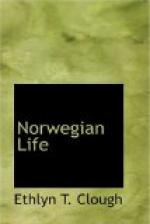The time about the year 1820 is reckoned as the beginning of the new Norwegian literature, and Henrik Wergeland is called its creator. Henrik Arnold Wergeland was born in 1808. His father, Nicolai Wergeland, a clergyman, was a member of the Constitutional Convention at Eidsvold. Henrik studied theology, but did not care to become a clergyman. In 1827, and the following years, he wrote a number of satirical farces under the signature Siful Sifadda. In 1830 appeared his lyric, dramatic poem, Skabelsen, Mennesket og Messias, (The Creation, Man and Messiah), a voluminous piece ’of work, in which he attempted to explain the historical life of the human race. As a political writer he was editorial assistant on the Folkebladet (1831-1833), and edited the opposition paper Statsborgeren (1835-1837). He worked with great zeal for the education of the laboring class, and from 1839 until his death edited a paper in the interest of the laborer. The prominent features of his earliest efforts in literature are an unbounded enthusiasm and a complete disregard of the laws of poetry. At an early age he had become a power in literature, and a political power as well. From 1831 to 1835 he was subjected to severe satirical attacks by the author Welhaven and others, and later his style became improved in every respect. His popularity, however, decreased as his poetry improved, and in 1840 he had become a great poet but had no political influence. Among his works may be named Hasselnoedder, Joeden, “The Jew,” Jodinden, “The Jewess,” Jan van Huysum’s Blomsterstykke, “Jan van Huysum’s Flowerpiece,” Den Engleske Lods, “The English Pilot,” and a great number of lyric poems. The poems of his last five years are as popular to-day as ever. Wergeland died in 1845.




